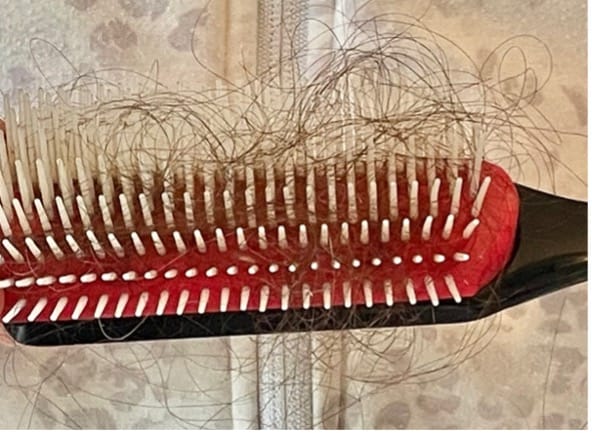40-50% of women experience female pattern hair loss with decrease in thickness, volume, dryness and thinning of hair mainly at the crown and sides of the head during menopause transition.
Hormonal change after menopause ie reducing estrogen with a relative increase in androgens (testosterone) results in scalp hair loss and increase in facial hair for some women.
If you notice unusual hair loss , it’s important to discuss with your GP and seek a specialist Dermatology opinion if required .
Hair loss can have a psychological impact with reduced self-esteem, embarrassment and feeling of isolation. Refer to www.alopecia.org.uk
Common Causes
A) Hormone changes during menopause transition
- During menopause transition there is a decrease in estrogen and a relative increase in androgen ( male hormone – testosterone). Decrease in estrogen results in decrease in binding protein which binds testosterone, therefore more testosterone is in free form and this relative increase contributes to hair loss.
- Decrease in aromatase activity: Testosterone is converted to estrogen by aromatase enzyme in fatty tissue and this decreases after menopause results in reduced estrogen levels.
- Androgen interferes with the signalling pathway connected with hair growth and increases pro-inflammatory markers in surrounding tissues.
B) Other changes due to low estrogen and progestogen
- Low estrogen affects metabolic health of follicles due to increasing insulin resistance. Hair follicles requires energy to produce hair and with ageing there is a decline in energy levels of the body .
- Low estrogen also reduces blood supply to follicles
- Progesterone can also inhibit signalling pathways
C) Other causes which need to be ruled out are
- Underactive thyroid, iron deficiency anaemia, polycystic ovarian syndrome (PCOS), high prolactin levels, malabsorption , liver and kidney disorders, malignancy.
- Genetic- family history of hair loss
- Acute emotional stress, crash dieting, use of weight loss drugs like Ozempic, Mounjaro
- Medications: anti-cancer , anti-convulsant, anti-hypertensive , anti-coagulants etc
All patients require an examination and referral in some complex cases for a dermoscopy .
There are 4 types of Hair loss
- Female pattern hair loss is most common type of hair loss, affecting up to 40-50% of menopausal women, with thinning of the part line followed by diffuse hair loss radiating from top of head. The scalp maybe visible in some cases and this pattern of hair loss is called Christmas tree pattern.
- Telogen Effluvium occurs during periods of stress such as after child birth, major surgery, bereavement and can take up to 6 months or longer to recover . This responds to steroids.
- Frontal Fibrosing Alopecia – mainly frontal hair line recession with loss of eyebrows seen in post-menopausal women , could be due to increase in androgens and lack of estrogen causing inflammation at the follicle. Other causes are auto-immune or allergic reaction to cosmetics which respond to immunosuppressants.
- Alopecia areata is an auto-immune condition that causes patchy hair loss responds to steroids .
Management of Female pattern Hair loss
- Healthy balanced diet with adequate protein intake 1gm/kg , supplements such iron tablets if anaemic, Vitamin D supplements, Biotin supplements
- Reduce use of straighteners, heat damaging tools, avoid using shampoos with parabens and sulphates
- HRT has limited efficacy when compared with standard Rx
- Minoxidil 2% solution or 5% foam applied to scalp once a day is an FDA approved treatment , but can cause irritation in some. Results are seen after at least 2 months of use, peaks around 6 months . If there is no response in 12 months discontinue treatment. Please refer to patient information leaflet for contra-indications for using Minoxidil.
- Androgen blockers prescribed by Dermatologists or your GP include drugs such as spironolactone, Cyproterone , finasteride and are used off label , especially useful in cases of PCOS as they have excess androgens.
- Low level Laser treatment
- Injection of platelet rich plasma (PRP)- uses patients own plasma injection into scalp , may work for some.
- Aesthetics such as Camouflaging, dyeing , wearing wigs
- Hair transplant
